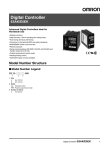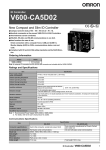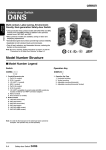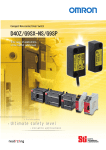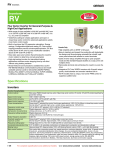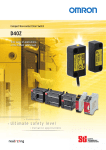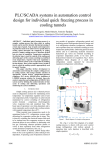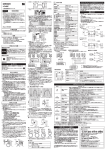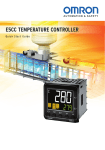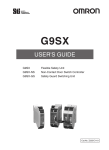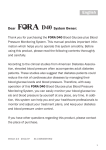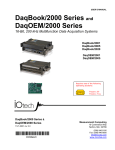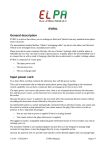Download D40A/G9SX-NS
Transcript
NEW Compact Non-Contact Door Switch/ Flexible Safety Unit D40A/G9SX-NS Stable Operation Increases Line Efficiency New Type of Non-Contact Door Switches for Worker Safety and Higher Productivity These new Non-Contact Door Switches provide more stability in detection than previously possible with non-contact door switches. ● Easy-to-see 2-Color Indicators Switch status is easy to see at a glance with these red/yellow LED indicators. Yellow: Closed door detected. Red: Open door detected. ● Small Not lit: Power OFF or failure Actuator An actuator that is smaller than the switch saves space, even inside the door. Even when mounted with an L-bracket, the actuator's height will not hinder installation or operation. Compact Switch Actuator Solves Conventional Switch Issues to Provide Stable Detection Issue 1 The Switch does not accurately detect the door when it is closed slowly, resulting in an error. Conventional switch An error can occur if the door is closed slowly with conventional switches. Door closed slowly. Solution 1 The D40A does not use reed switches and provides stable detection with electronic switches. Conventional Switches Slow Magnet Reed switch contacts Slow Magnet Reed switch contacts Error If the switching timing of reed switch contacts 1 and 2 varies too much, the Controller detects an error and turns OFF the output to maintain safety. Note: The figure is intended only as an illustration. Is Stable Detection with the D40A's New System Detects slow lateral operation. Detects slow rotating operation. So rror. eration. ● Mount from Either Side Mount from whichever side provides the easiest wiring path to enable mounting to all types of doors. Swinging doors ● Connect Mount from Either Side Sliding doors Up to 30 Switches to a Single Controller Reduce costs by connecting up to 30 Switches to a single Controller. Up to 30 Switches Issue 2 It is nearly impossible to tell which door is open in a multi-door application. If an error occurs... The system cannot be started because the Controller has turned OFF the output even though all doors appear to be closed. It's impossible to tell if there is a door open or if an error has occurred. All doors must be opened and closed before operation can be started. Solution 2 With the D40A... The auxiliary outputs can be used to easily indicate which door is open. And with two-color indicators, mounting adjustments are also easy. The D40A is the first Non-contact Door Switch to combine 2-color indicators, auxiliary outputs, and 30-switch connection capacity, allowing you to create a better safety environment. Two Types of Controller to Solve Productivity, Expandability, and Maintenance Issues The G9SX-NS and G9SX-NSA are designed specifically for use with the D40A, and with the G9SX-NSA you can also connect mechanical safety door switches. Among other features, these Controllers support logical AND connections that enable partial stops. These Controllers make the most of D40A Switches. ● Two Different Controllers G9SX-NS G9SX-NSA @Logical AND connection input @Logical AND connection input @D40A input @D40A plus mechanical safety door switch input, channel 1 or 2 @Two instantaneous safety outputs @Two instantaneous safety outputs @Two OFF-delay safety outputs @Logical AND connection output @Logical AND connection output Reduce Costs with these New-Concept Controllers Issue 1 Two Controllers are required for emergency stop switches and non-contact door switches. Application ●One hazard. ●The system must be stopped when either a door is opened or an emergency stop switch is pressed. D40B D40B-J1 Emergency stop switch (See note.) The G9SA must be added to connect the G9SA emergency stop switch. D40A Emergency stop switch (See note.) Two Controllers The D40A Simplifies the Configuration With only one G9SXNSA222-T03@ Controller, both a Noncontact Door Switch and an emergency stop switch can be connected. G9SX-NSA One Controller ● Indicators That Make Maintenance Easier The indicators show the location and cause of wiring errors and any other errors that are detected. Auxiliary outputs for errors also contribute to reducing down time. Input error Logical AND connection error Output error ● Mechanical Safety Door Switches Can Also Be Connected with the G9SX-NSA Inputs can be accepted from both D40A Switches and mechanical switches to reduce the number of Controllers and costs. D40A Safety Door Switches ● Expansion Units to Easily Increase the Number of Outputs with the G9SX-NSA The number of outputs can be easily increased using connectors. Up to 25 outputs can be configured. Up to 25 Outputs G9SX-EX Expansion Unit Issue 2 Another Controller has to be added to use an OFF-delay timer. Application D40A ●Two hazards. ●The power supply must be turned OFF immediately when the emergency stop switch is pressed. ●When a door is opened, a stop signal is sent to only servomotor B and then the power supply is turned OFF. D40B-J1 Emergency stop switch (See note.) Wiring D40A Emergency stop switch (See note.) D40B The D40A Simplifies the Configuration G9SX-BC The G9SA must be A Controller can be G9SA added to use an G9SA-321-T@ OFF-delay output OFF-delay timer. eliminated because the G9SX-NSA222T03@ provides an One Controller G9SX-NSA Logical AND connection Three A B Controllers OFF-delay output. A B Two Controllers Note: Always use a manual reset when using an emergency stop. Configuration Example for Logical AND Connections with the G9SX Logical AND Connections OMRON's unique logical AND connections enable easily constructing safety circuits that were troublesome with previous Controllers. The new Non-contact Door Switch Controllers embody the concepts for the G9SX Series, so you can also use the previous G9SX-series Controllers in the same system. Small Assembly System ●Both robots will stop when the emergency stop switch is pressed. ●Robot A will stop when robot door A is opened. ●Robot B will stop when robot door B is opened. (1) Emergency stop switch (2) Robot door A (3) Robot door B D40A D40A G9SX-BC Logical AND connections Robot door B Robot door A G9SX-NS G9SX-NS Operation Examples (1) Emergency stop switch pressed. (2) Robot door A opened. Stop Stop Robot A (3) Robot door B opened. Stop Stop Stop Robot B Robot A Robot B Robot A Robot A Robot B Robot B Semiconductor Inspection System ●The entire system will stop if the emergency stop switch is pressed. ●Only segment A will stop if door A (with door switch) is opened. ●Only segment B will stop if door B (with door switch) is opened. ●Only segment C will stop if the door with the D40A is opened. (2) Door A (with door switch) (1) Emergency stop switch (3) Door B (with door switch) (2) Door A (3) Door B (4) Door with D40A (4) Door with the D40A Safety Door Switch G9SX-BC Safety Door Switch D40A G9SX-AD G9SX-NS Logical AND connections (1) Emergency stop switch Segment A Segment B Segment C Operation Examples (1) Emergency stop switch pressed. Stop Stop Stop Segment A Segment B Segment C (3) Door B opened. (2) Door A opened. G9SX-AD Stop Segment A Segment B Segment C (4) Door with D40A opened. Stop Stop Stop Stop Stop Stop Segment A Segment A Segment B Segment C Segment B Segment A Segment B Segment C Segment C Note: Refer to the G9SX datasheet (Cat. No. J150) and to the 2006 Safety Components Series Group Catalog (Cat. No. Y106) for details on logical AND connections and the G9SX-series Controllers. Compact Non-Contact Door Switch/Flexible Safety Unit D40A/G9SX-NS Electronic Detection Mechanism for Better Stability in Non-contact Door Switch Operation • Stable operation reduces Controller errors caused by unstable doors. • Connect up to 30 Non-contact Door Switches with LED indicators to one Controller. • Reversible switch provides flexibility in installation. • Two-color LED indicator enables easier maintenance by identification of door status and cable disconnections. • Safety category 3 (EN 954-1). • Both Non-contact Door Switches and conventional Key-type Safety-door Switches can be input to one Controller, saving space. • OFF-delay output provided for stop category 1. • Easily construct partial stop and complete stop systems with the logical AND connection function, using G9SX as the Controller. Refer to “Precautions” on page 28. Model Number Structure ■ Model Number Legend Non-Contact Door Switch (Switch/Actuator) D40A - @@@ 1 2 3 1. Type 1: Standard model 2. Auxiliary outputs C: 1NO (PNP transistor output) 3. Cable length 2: 2 m 5: 5 m Non-Contact Door Switch Controller G9SX - @@@@@@ - @@@ - @@ 1 2 3 4 5 1. Functions NS/NSA: D40A Controller EX: Expansion Unit 2. Output Configuration (Instantaneous Safety Outputs) 2: 2 outputs 4: 4 outputs 3. Output Configuration (OFF-delayed Safety Outputs) 0: None 2: 2 outputs 6 4. Output Configuration (Auxiliary Outputs) 1: 1 output 2: 2 outputs 5. Max. OFF-delay Time 6. Terminal Block Type RT: Screw terminals RC: Spring-cage terminals D40A Controller T03: 3 s (Variable) Expansion Unit Blank: No OFF delay T: OFF delay Compact Non-Contact Door Switch D40A/Flexible Safety Unit G9SX-NS 7 Ordering Information Non-Contact Door Switches (Switch/Actuator) Classification Appearance Auxiliary outputs Standard models Semiconductor outputs (See note 2.) Cable length Mode 2m D40A-1C2 5m D40A-1C5 Note: 1. Must be used in combination with a G9SX-NS@ Non-contact Door Switch Controller. 2. PNP open-collector semiconductor output. Non-Contact Door Switch Controllers (Controllers for D40A) Max. OFF Logical Logical Auxiliary outputs AND con- AND con- delay time nection (See note 4.) OFF-delayed (See note nection output input 3.) (See note 2.) Safety outputs (See note.1) Instantaneous 1 0 2 2 (Semicon(Semiconductors) ductors) 2 (Semiconductors) Note: 1. 2. 3. 4. 1 --- Rated voltage 24 VDC Terminal block type Screw terminals Model G9SX-NS202-RT Spring-cage terminals G9SX-NS202-RC 3.0 s Screw terminals G9SX-NSA222-T03-RT Spring-cage terminals G9SX-NSA222-T03-RC P channel MOS FET transistor output The OFF-delayed output becomes an instantaneous output by setting the OFF-delay time to 0 s. PNP transistor output The OFF-delay time can be set in 16 steps as follows: 0/0.2/0.3/0.4/0.5/0.6/0.7/0.8/0.9/1.0/1.2/1.4/1.8/2.0/2.5/3.0 s Expansion Units Safety outputs Instantaneous 4PST-NO --- OFF-delayed --4PST-NO Auxiliary outputs OFF-delay time Rated voltage Terminal block type --1 (Semiconductor) (See note 1.) (See note 2.) 24 VDC Screw terminals Model G9SX-EX401-RT Spring-cage terminals G9SX-EX401-RC Screw terminals G9SX-EX041-T-RT Spring-cage terminals G9SX-EX041-T-RC Note: 1. PNP transistor output 2. The OFF-delay time is synchronized to the OFF-delay time setting in the connected Controller (G9SX-NSA222-T03-@). 8 Compact Non-Contact Door Switch D40A/Flexible Safety Unit G9SX-NS Specifications ■ Ratings/Characteristics of Non-contact Door Switches Item Operating characteristics (See note 1.) Model D40A-1C@ Operating distance OFF→ON 5 mm min. Operating distance ON→OFF 15 mm max. Differential travel (max.) 20% of operating distance Influence of temperature (max.) ±20% of operating distance at 23°C, within temperature range of −10 to 55°C Ambient operating temperature −10 to 55°C (no icing or condensation) Ambient operating humidity 25% to 85% Insulation resistance (between charged parts and case) 50 MΩ max. (at 500 VDC) Dielectric strength (between charged parts and case) 1,000 VAC for 1 min Vibration resistance 10 to 55 to 10 Hz (single amplitude: 0.75 mm, double amplitude: 1.5 mm) Shock resistance 300 m/s2 min. Degree of protection IP67 Material PBT resin Mounting method M4 screws Terminal screw tightening torque 1 N·m Power consumption 0.6 W max. Auxiliary outputs (See note 2.) 24 VDC, 10 mA (PNP open-collector outputs) LED indicators Actuator not detected (red); actuator detected (yellow) Connection cables 2 m, 5 m Number of connectable switches (See note 3.) 30 max. (wiring length: 100 m max.) Weight Switch: approx. 145 g, actuator: approx. 20 g (D40A-1C2) Note: 1. This is the distance where the switch operates from OFF to ON when approaching and the distance where the switch operates from ON to OFF when separating when the switch and actuator target marks are on the same axis, and the sensing surfaces coincide. 2. Turns ON when the actuator is approaching. 3. For details, refer to item 5 on page 29. Compact Non-Contact Door Switch D40A/Flexible Safety Unit G9SX-NS 9 ■ Ratings of Non-contact Door Switch Controllers Power input Item Model Rated supply voltage G9SX-NS202-@ G9SX-NSA222-T03-@ G9SX-EX-@ 24 V DC Operating voltage range −15% to 10% of rated supply voltage Rated power consumption (See note.) 3 W max. 4 W max. 2 W max. Note: Power consumption of loads not included. Inputs Item Model G9SX-NS202-@/G9SX-NSA222-T03-@ Operating voltage: 20.4 VDC to 26.4 VDC, internal impedance: approx. 2.8 kΩ Safety input (See note.) Feedback/reset input Note: Only applies to the G9SX-NSA222-T03-@. Refers to input other than that from the Non-contact Door Switch. Outputs Item Model G9SX-NS202-@/G9SX-NSA222-T03-@ Instantaneous safety output (See note 1.) P channel MOS FET transistor output OFF-delayed safety output (See note 1.) Load current: 0.8 A DC max. (See note 2.) Auxiliary output PNP transistor output Load current: 100 mA max. Note: 1. While safety outputs are in the ON state, the following signal sequence is output continuously for diagnosis. When using the safety outputs as input signals to control devices (i.e. Programmable Controllers), consider the OFF pulse shown below. Approx.100 ms ON OFF 360 µs max. 2. The following derating is required when Units are mounted side-by-side. G9SX-NS202-@/G9SX-NSA222-T03-@: 0.4 A max. load current Expansion Unit Item Model G9SX-EX-@ Rated load 250 VAC, 3 A/30 VDC, 3 A (resistive load) Rated carry current 3A Maximum switching voltage 250 VAC, 125 VDC 10 Compact Non-Contact Door Switch D40A/Flexible Safety Unit G9SX-NS ■ Characteristics Item Model G9SX-NS202-@ G9SX-NSA222-T03-@ G9SX-EX-@ Over-voltage category (IEC/EN 60664-1) II II (Relay outputs 13 to 43 and 14 to 44: III) Operating time (OFF to ON state) (See note 1.) 100 ms max. (Logical AND connection input ON and Noncontact Door Switch input ON) 30 ms max. (See note 4.) 50 ms max. (Safety input: ON) (See note 2.) 100 ms max. (Logical AND connection input ON and Non-contact Door Switch input ON) (See note 3.) Response time (ON to OFF state) (See note 1.) 15 ms max. (Logical AND connection input: OFF) 20 ms max. (Non-contact Door Switch input OFF) 10 ms max. (See note 4.) 15 ms max. (Safety input OFF and logical AND connection input OFF) 20 ms max. (Non-contact Door Switch input: OFF) ON-state residual voltage 3.0 V max. (safety output, auxiliary output) OFF-state leakage current 0.1 mA max. (safety output, auxiliary output) Maximum wiring length of safety input, logical AND connection input, and Non-contact Door Switch input 100 m max. (External connection impedance: 100 Ω max. and 10 nF max.) Reset input time (Reset button pressing time) 100 ms min. Accuracy of OFF-delay time (See note 5.) --- Within ±5% of the set value 20 MΩ min. (at 100 VDC) Insulation Between logical AND resistance connection terminals, and power supply input terminals and other input and output terminals connected together Dielectric strength Within ±5% of the set value --- Between all terminals connected together and DIN rail 100 MΩ min. (at 500 VDC) 500 VAC for 1 min. Between logical AND connection terminals, and power supply input terminals and other input and output terminals connected together --- Between all terminals connected together and DIN rail 1,200 VAC for 1 min Between different poles of outputs --- Between relay outputs connected together and other terminals connected together 2,200 VAC for 1 min Vibration resistance 10 to 55 to 10 Hz, 0.375-mm single amplitude (0.75-mm double amplitude) Shock Destruction resistance Malfunction 300 m/s2 Durability Electrical --- 100,000 cycles min. rated load, switching frequency: 1,800 cycles/ hour) Mechanical --- 5,000,000 cycles min. (switching frequency: 7,200 cycles/hour) 100 m/s2 Ambient operating temperature −10 to 55°C (no icing or condensation) Ambient operating humidity 25% to 85% Terminal tightening torque 0.5 N·m (For the G9SX-NS@-RT (with screw terminals) only) Weight Approx. 125 g Approx. 200 g Approx. 165 g Note: 1. When two or more Units are connected by logical AND, the operating time and response time are the sum total of the operating times and response times, respectively, of all the Units connected by logical AND. 2. Represents the operating time when the safety input turns ON with all other conditions set. 3. Represents the operating time when the logical AND input and the Non-contact Door Switch input turn ON with all other conditions set. 4. This does not include the operating time or response time of G9SX-NS@ that are connected. 5. This does not include the operating time or response time of internal relays in the G9SX-EX-@. Compact Non-Contact Door Switch D40A/Flexible Safety Unit G9SX-NS 11 Logical AND Connection Item Model Number of Units connected per logical AND output G9SX-NS202-@ G9SX-NSA222-T03-@ 4 Units max. G9SX-EX-@ --- Total number of Units connected by logical 20 Units max. AND (See note 2.) --- Number of Units connected in series by logical AND 5 Units max. --- Max. number of Expansion Units connected (See note 3.) --- 5 Units max. Maximum cable length for logical AND input 100 m max. --- Note: 1. See Logical AND Connection Combinations below for details. 2. The number of G9SX-EX401-@ Expansion Units or G9SX-EX041-T-@ Expansion Units (OFF-delayed Model) not included. 3. G9SX-EX401-@ Expansion Units and G9SX-EX041-T-@ Expansion Units (OFF-delayed Model) can be mixed. Logical AND Connection Combinations 1. One logical AND connection output from a G9SX-NS@ Controller can be logical AND connected to up to four Controllers. 3. The largest possible system configuration contains a total of 20 G9SX-NS@ Controllers, G9SX-AD@ Advanced Units, and G9SXBC Basic Units. In this configuration, each Controller or Advanced Unit can have up to five Expansion Units. G9SX-NS@ G9SX-@ G9SX-NS@ G9SX-NS@ G9SX-NS@ G9SX-NS@ G9SX-AD@ or G9SX-NS@ G9SX-AD@ or G9SX-NS@ G9SX-AD@ or G9SX-NS@ G9SX-AD@ or G9SX-NS@ G9SX-AD@ or G9SX-NS@ G9SX-AD@ or G9SX-NS@ G9SX-AD@ or G9SX-NS@ G9SX-AD@ or G9SX-NS@ G9SX-AD@ or G9SX-NS@ G9SX-AD@ or G9SX-NS@ G9SX-AD@ or G9SX-NS@ G9SX-AD@ or G9SX-NS@ G9SX-AD@ or G9SX-NS@ G9SX-AD@ or G9SX-NS@ G9SX-AD@ or G9SX-NS@ G9SX-AD@ or G9SX-NS@ 2. Any G9SX-NS@ Controller that receives a logical AND connection input can be logically connected to other Controllers on up to five layers. G9SX-NS@ G9SX-NS@ G9SX-NS@ G9SX-NS@ G9SX-NS@ Number of Units connected in series by logical AND: 5 Units max. Note: The G9SX-NS@ in the above diagram can be replaced by the G9SX-AD@ Advanced Unit. For details on G9SX-AD@ Advanced Units, refer to the G9SXseries Flexible Safety Unit catalog. (Cat. No. J150). 12 Compact Non-Contact Door Switch D40A/Flexible Safety Unit G9SX-NS G9SX-AD@ or G9SX-NS@ Number of Units connected per logical AND output: 4 Units max. G9SX-AD@ or G9SX-NS@ G9SX-AD@ or G9SX-NS@ Total number of Units connected by logical AND: 20 Units max. Response Time and Operating Time 1. G9SX-NS@ Max. response time (excluding Expansion Units) (See note 1.) Non-contact Door Switch input Logical AND input Max. operating time (excluding Expansion Units) (See note 2.) Non-contact Door Switch input 20 ms 100 ms Logical AND input 100 ms 20 ms Note: 1. The maximum response time is the time it takes the output to switch from ON to OFF after the input switches from ON to OFF. 2. The maximum operating time is the time it takes the output to switch from OFF to ON after the input switches from OFF to ON. 2. G9SX-NSA@ Non-contact Door Switch input Max. response time (excluding Expansion Units) (See note 1.) D4NS Safety input Logical AND input Max. operating time (excluding Expansion Units) (See note 2.) Non-contact Door Switch input 20 ms 100 ms Safety input 15 ms 50 ms Logical AND input 20 ms 100 ms Note: 1. The maximum response time is the time it takes the output to switch from ON to OFF after the input switches from ON to OFF. 2. The maximum operating time is the time it takes the output to switch from OFF to ON after the input switches from OFF to ON. 3. Multiple G9SX-NS@/NSA@ Non-contact Door Switch Controllers When multiple Controllers are logically connected with AND connections, the response time is the sum of the response times given in 1 and 2 above. (It is the same for the operating time.) D4NS Case 1 D40A (1) Safety input Response Time from When D40A (1) Turns from ON to OFF until Safety Output (2) Turns from ON to OFF ( 20 ms (D40A (1)) + 20 ms = (Logical AND connection (1)) 40 ms Case 2 Safety output (1) Logical AND (1) D40A (2) Response Time from When D4NS Turns from ON to OFF until Safety Output (3) Turns from ON to OFF 15 ms (D4NS) + 20 ms + (Logical AND connection (1)) 20 ms = (Logical AND connection (2)) 55 ms Safety output (2) D40A (3) Logical AND (2) Safety output (3) Compact Non-Contact Door Switch D40A/Flexible Safety Unit G9SX-NS 13 Engineering Data Operating distance Y (mm) Operating distance Y (mm) Detection Ranges (Typical Characteristics Data) 16 14 OFF 12 10 14 12 OFF 10 8 8 6 ON 6 ON 4 4 2 2 0 −6 −4 −2 0 2 4 Distance from the target mark on the switch X (mm) X 6 0 −15 −10 −5 0 Sensing surface Sensing surface Z Y Target marks Y Target marks Note: 1. The operating distance is the distance between the switch and actuator sensing surfaces. 2. Data in the diagram is typical data at an ambient temperature of 23°C. Actual operating values may vary. The operating distance may be affected by ambient metal, magnet catches, and temperature. 14 5 10 15 Distance from the target mark on the switch Z (mm) Compact Non-Contact Door Switch D40A/Flexible Safety Unit G9SX-NS Connections ■ Internal Connection G9SX-NS202-@ (Non-contact Door Switch Controller) A1 D1 D2 D3 D4 T31 T32 T33 T41 T42 A1 (See note 2.) Logical AND input S14 S24 L1 X1 T11 T12 T21 T22 T31 T32 T33 Y1 D1 D2 D3 D4 T41 T42 (See note 2.) Power Non-contact Door Reset/Feedback supply Input Switch control circuit Auxiliary (See Safety output control output control note 1.) A2 G9SX-NSA222-T03-@ (Non-contact Door Switch Controller) Power supply circuit (See note 1.) Safety input 1 Safety input 2 fault Reset/Feedback Cross detection Non-contact Door Input Switch control input Safety output control Auxiliary output control Logical AND input Expansion Unit output control X2 A2 (See note 3.) S14 S24 S44 S54 L1 X1 X2 (See note 3.) Note: 1. Internal power supply circuit is not isolated. 2. Logical AND input is isolated. 3. Outputs S14 to S24 are internally redundant. G9SX-EX401-@/G9SX-EX041-T-@ (Expansion Unit/Expansion Unit OFF-delayed Model) A1 Note: 1. Internal power supply circuit is not isolated. 2. Logical AND input is isolated. 3. Outputs S14 to S54 are internally redundant. 13 23 33 43 (See note 1.) Exp. sig. IN Safety output Power control supply Auxiliary circuit output control A2 X2 (See note 2.) K1 Exp. sig. OUT K2 14 24 34 44 Note: 1. Internal power supply circuit is not isolated. 2. Relay outputs are isolated. ■ Internal Circuit Diagram D40A-1C@ Brown Internal circuit Blue White Black Yellow Compact Non-Contact Door Switch D40A/Flexible Safety Unit G9SX-NS 15 Dimensions Note: All units are in millimeters unless otherwise indicated. Non-contact Door Switch (Switch/Actuator) D40A-1C2 D40A-1C5 48 7.2 dia. 48 7.2 dia. 12 38 7.2 dia. Sensing surface 6 13 17 9.5 Sensing surface 7.2 dia. 38 Indicator (2) Two, 4.2 dia. (2) 20 25 Two, 4.2 dia. Vinyl-insulated round cord, dia. 4, 5-conductor (conductor cross-sectional area: 0.2 mm2,Insulator diameter: 1.0 mm) Standard length: 2 m/5 m 13 (Actuator) (Switch) Non-contact Door Switch Controller (6) (See note 3.) G9SX-NS202-@ Terminal arrangement T31 T32 T33 D3 D1 D2 X1 A1 T31 T32 T33 D3 D1 D2 X1 A1 G9SX-NS202 24VDC PWR EI PWR FB AND NS FB AND 100 max. NS ERR EI ERR No. T41 T42 X2 S14 S24 L1 A2 D4 T41 T42 X2 A2 S14 S24 L1 D4 23 max. 115 max. (6) (See note 3.) (22.5)(See note 1.) Note: 1. Typical dimension 2. Above outline drawing is for models with spring-cage terminals (-RC). 3. For models with spring-cage terminals (-RC) only. Non-contact Door Switch Controller Terminal arrangement (6) (See note 3.) G9SX-NSA222-T03-@ T31 T32 T33 D1 D2 D3 T11 T12 Y1 X1 X2 A1 T31 T32 T33 D1 T11 T12 Y1 X1 D2 X2 D3 A1 G9SX-NSA222-T30 24VDC PWR 0.7 0.6 0.5 0.4 0.3 0.2 FB T1 T2 AND NS EI ED 0.8 0.91.0 1.2 1.4 1.8 2.0 2.5 0 3.0 OFF-DELAY PWR FB T1 T2 AND NS EI ED 100 max. ERR ERR No. T21 T22 T41 T42 S14 S24 S44 S54 L1 A2 D4 T21 T22 T41 T42 A2 S14 S24 S44 S54 L1 D4 35.5 max. (10) (35) (See note 1.) 115 max. (6) (See note 3.) Note: 1. Typical dimension 2. Above outline drawing is for models with spring-cage terminals (-RC). 3. For models with spring-cage terminals (-RC) only. 16 Compact Non-Contact Door Switch D40A/Flexible Safety Unit G9SX-NS Expansion Unit G9SX-EX401-@ Expansion Unit (OFF-delayed Model) G9SX-EX041-T-@ Terminal arrangement G9SX-EX401-@ (Expansion Unit) G9SX-EX041-T-@ (Expansion Unit with OFF Delay) 13 23 33 43 13 23 33 43 PWR PWR EI ED ERR ERR (6) (See note 3.) 100 max. 23 max. 115 max. (22.5) (See note 1.) A1 X2 A2 A1 X2 A2 14 24 34 44 14 24 34 44 (6) (See note 3.) Note: 1. Typical dimension 2. Above outline drawing is for models with spring-cage terminals (-RC). 3. For models with spring-cage terminals (-RC) only. Compact Non-Contact Door Switch D40A/Flexible Safety Unit G9SX-NS 17 ■ Non-contact Door Switch and Non-contact Door Switch Controller Wiring Example: Wiring a Single Switch Example: Wiring Multiple Switches Connect Up to 30 Non-contact Door Switches D1 D2 D3 D4 Blue Brown Black White Blue Brown Black White Blue Brown Auxiliary output load (See note.) Black White Blue Yellow Black Brown White D40A-1C@ A2 G9SX-NS202-@ G9SX-NSA222-T03-@ Note: The auxiliary output load current must be 10 mA max. D1 D2 D3 D4 G9SX-NS202-@ G9SX-NSA222-T03-@ Wiring of Inputs and Outputs Signal name Non-contact Door Switch power supply input Wire color Brown Blue Description of operation Supplies power to the D40A. Connect to the D3 or D4 terminal of the G9SX-NS@. Non-contact Door Switch input White Inputs signals from the G9SX-NS@. The Non-contact Door Switch input must be ON as a required condition for the Non-contact Door Switch output to be ON. Non-contact Door Switch output Black Turns ON and OFF according to actuator detection and the status of the Non-contact Door Switch input. Auxiliary output Yellow Turns ON when actuator is detected. 18 Compact Non-Contact Door Switch D40A/Flexible Safety Unit G9SX-NS ■ Wiring of Inputs and Outputs G9SX-NS202-@ Signal name Power supply input Terminal name A1, A2 Non-contact Door D1, D2, Switch input D3, D4 Description of operation Wiring Connect the power source to the A1 and A2 terminals. Connect the power supply plus (24 VDC) to the A1 terminal. Connect the power supply minus (GND) to the A2 terminal. All Non-contact Door Switch inputs connected to the G9SX-NS@ must be ON as a required condition for the safety outputs to be ON. Otherwise the safety outputs cannot be in the ON state. White D1 Feedback/reset input T31, T32, T33 T41, T42 D2 To set the safety outputs in the ON state, the ON state Auto reset signal must be input to T33. Otherwise the safety outputs cannot be in the ON state. A logical AND connection means that one unit (Unit A) outputs a safety signal “a” to a subsequent unit (Unit B) and Unit B calculates the logical AND (i.e., outputs the AND) of the signal “a” and safety signal “b”, which is input to Unit B. Thereby the logic of the safety output of Unit B is (AND). (An AND of inputs “a” and “b” is output.) To set the safety outputs of the subsequent Unit in the ON state, its logical AND connection preset switch must be set to AND (enable) and the high signal must be input to T41 of the subsequent unit. Blue D3 D4 Feedback loop KM +24 V T31 To set the safety outputs in the ON state, the signal in- Manual reset put to T32 must change from the OFF state to the ON state, and then to the OFF state. Otherwise the safety outputs cannot be in the ON state. Logical AND connection input Black Brown T32 T33 Feedback loop Reset Switch KM +24 V T31 T32 T33 Input a Unit A G9SX-NS/NSA Output (a) L1 A2 Unit B Logical AND connection sig. (1st layer) Input b T41 T42 G9SX-NS/NSA Output (a&b) L1 A2 Next unit (4 unit max.) T41 T42 G9SX-NS/NSA Logical AND connection sig. (2nd layer) Next unit (4 unit max.) T41 T42 G9SX-NS/NSA L1 A2 Next unit (5 layers max.) Instantaneous safety output S14, S24 Turns ON/OFF according to the state of the safety in- Keep these outputs open when not used. puts, Non-contact Door Switch inputs, feedback/reset inputs, and logical AND connection inputs. During OFF-delay state, the Instantaneous safety outputs are not able to turn ON. Logical AND L1 connection output Outputs a signal of the same logic and at the same time as the instantaneous safety outputs. Keep these outputs open when not used. Auxiliary monitor output X1 Outputs a signal of the same logic and at the same time as the instantaneous safety outputs Keep these outputs open when not used. Auxiliary error output X2 Outputs when the error indicator is lit or flashing. Keep these outputs open when not used. Compact Non-Contact Door Switch D40A/Flexible Safety Unit G9SX-NS 19 G9SX-NSA222-T03-@ Signal name Terminal name Description of operation Wiring Power supply input A1, A2 Connect the power source to the A1 and A2 terminals. Connect the power supply plus (24 VDC) to the A1 terminal. Connect the power supply minus (GND) to the A2 terminal. Safety input 1 To set the safety outputs in the ON state, the high state Corresponds to Safety Categosignals must be input to both safety input 1 and safety ry 2 input 2. Otherwise the safety outputs cannot be in the ON state. T11, T12 +24 V +24 V T11 T12 T21 T22 Corresponds to Safety Category 3 (without short-circuit monitoring between systems) Safety input 2 +24 V Y1 +24 V +24 V T21, T22 T11 T12 T21 T22 Y1 T11 T12 T21 T22 Y1 Corresponds to Safety Category 3 (Cross fault detecting mode (for safety inputs)) NC Non-contact Door Switch input D1, D2, D3, D4 All Non-contact Door Switch inputs connected to the G9SX-NS must be ON as a required condition for the safety outputs to be ON. Otherwise the safety outputs cannot be in the ON state. White D1 Feedback/reset input Black Brown D2 Blue D3 D4 T31, T32, To set the safety outputs in the ON state, the ON state Auto reset T33 signal must be input to T33. Otherwise the safety outputs cannot be in the ON state. Feedback loop +24 V T31 To set the safety outputs in the ON state, the signal in- Manual reset put to T32 must change from the OFF state to the ON state, and then to the OFF state. Otherwise the safety outputs cannot be in the ON state. T41, T42, A logical AND connection means that one unit (Unit A) T51, T52 outputs a safety signal “a” to a subsequent unit (Unit B) and Unit B calculates the logical AND (i.e., outputs the AND) of the signal “a” and safety signal “b”, which is input to Unit B. Thereby the logic of the safety output “b” is output.) To set the safety outputs of the subsequent Unit in the ON state, its logical AND connection preset switch must be set to AND (enable) and the high signal must be input to T41 of the subsequent unit. T33 Feedback loop Reset Switch KM +24 V T31 Logical AND connection input T32 KM T32 T33 Input a Unit A G9SX-NS/NSA Output (a) L1 A2 Unit B Logical AND connection sig. (1st layer) Input b T41 T42 G9SX-NS/NSA Output (a&b) L1 A2 Next unit (4 unit max.) T41 T42 G9SX-NS/NSA Logical AND connection sig. (2nd layer) Next unit (4 unit max.) T41 T42 G9SX-NS/NSA L1 A2 Next unit (5 layers max.) Cross fault detection input Y1 Selects the mode for the failure detecting (cross fault detecting) function for the safety inputs of G9SX corresponding to the connection of the cross fault detection input. Keep Y1 open when using T11, T21. (Cross fault detecting mode (for safety inputs)) Connect Y1 to 24 VDC when not using T11, T21. (Wiring corresponding to category 2 or 3, or when connecting safety sensors) Instantaneous safety output S14, S24 Turns ON/OFF according to the state of the safety in- Keep these outputs open when not used. puts, feedback/reset inputs, and logical AND connection inputs. During OFF-delay state, the Instantaneous safety outputs are not able to turn ON. OFF-delayed safety output S44, S54 OFF-delayed safety outputs. The OFF-delay time is set by the OFF-delay preset switch. When the delay time is set to zero, these outputs can be used as non-delay outputs. Logical AND connection output L1 Outputs a signal of the same logic and at the same time Keep these outputs open when not used. as the instantaneous safety outputs. Auxiliary monitor output X1 Outputs a signal of the same logic and at the same time Keep these outputs open when not used. as the instantaneous safety outputs. Auxiliary error output X2 Outputs when the error indicator is lit or flashing. Keep these outputs open when not used. Keep these outputs open when not used. ■ Connecting Safety Sensors Safety sensors cannot be connected to safety inputs for the G9SX-NSA222-T03-@. 20 Compact Non-Contact Door Switch D40A/Flexible Safety Unit G9SX-NS Operation ■ Functions Connecting Expansion Units Logical AND Connection A logical AND connection means that the G9SX outputs a safety signal “a” to another G9SX, and that G9SX creates the logical AND of safety signal “a” and safety signal “b.” The safety output of the G9SX-NSA222-T03-@ with the logical AND connection shown in the following diagram is “a” AND “b.” a b G9SX-NS202-@ G9SX-NSA222-T03-@ a • The G9SX-EX and G9SX-EX-T Expansion Units can be connected to a G9SX-NSA222-T3-@ Non-contact Door Switch Controller to increase the number of safety outputs. (They cannot be connected to a G9SX-NS202-@.) • A maximum of five Expansion Units can be connected to one G9SX-NSA222-T03-@. This may be a combination of G9SX-EX instantaneous models and G9SX-EX-T OFF-delayed models. • Remove the terminating connector from the receptacle on G9SXNSA222-T03-@ and insert the Expansion Unit cable connector into the receptacle. Insert the terminating connector into the receptacle on the Expansion Unit at the very end (rightmost). • When Expansion Units are connected to a Controller, make sure that power is supplied to every Expansion Unit. (Refer to the following diagram for actual Expansion Unit connection.) a (AND) b Terminating connector This is illustrated using the application in the following diagram as an example. The equipment here has two hazards identified as Robot 1 and Robot 2, and it is equipped with Non-contact Door Switches and an emergency stop button as safety measures. If the door to Robot 2 is opened, only Robot 2 is stopped (i.e., a partial stop). If the door to Robot 1 is opened or the emergency stop button is pressed, both Robot 1 and Robot 2 stop (i.e., a complete stop). G9SX-NSA222-T03-@ Expansion Unit The actual situation using a G9SX for this application is shown in this example. Note: The logical AND setting on the G9SX-NS202-@ must be set to AND (enabled). Non-contact Door Switch 2 Non-contact Door Switch 1 Emergency stop button Robot 2 Robot 1 Emergency stop button (See note.) D40A D40A G9SXNSA222-T03-@ G9SXNS202-@ Robot 1 Robot 2 Note: A manual reset is required when an emergency stop is used. Compact Non-Contact Door Switch D40A/Flexible Safety Unit G9SX-NS 21 Setting Procedure 3. Setting Logical AND Connection (G9SX-NS202-@/ NSA222-T03-@) 1. Cross Fault Detection (G9SX-NSA222-T03-@) Set the cross fault detection mode for safety inputs by shorting Y1 to 24 V or leaving it open. When cross fault detection is set to ON, short-circuit failures are detected between safety inputs T11-T12 and T21-22. When a cross fault is detected, the following will occur. (1) The safety outputs and logical AND outputs lock out. (2) The LED error indicator is lit. (3) The error output (auxiliary output) turns ON. Cross fault detection OFF Unit A AND L1 A2 T41 T42 OFF AND Wiring OFF Unit B Corresponds to Safety Category 2 +24 V Note: A setting error will occur and Unit B will lock out if the logical AND setting switch on the Unit is set to OFF. +24 V T11 Corresponds to Safety Category 3 T12 T21 +24 V T22 Y1 +24 V +24 V T11 ON When connecting two or more Non-contact Door Switch Controllers by logical AND connection, set the logical AND connection preset switch on the Controller that is on the input side (Unit B in the following diagram) to AND. Corresponds to Safety Category 3 (Cross fault detecting mode (for safety inputs)). T12 T21 T22 4. Setting the OFF-delay Time (G9SX-NSA222-T03-@) The OFF-delay preset time on G9SX-NSA222-T03-@ is set from the OFF-delay time preset switch (1 each on the front and back of the Unit). Normal operation will only occur if both switches are identically set. An error will occur if the switches are not identically set. Front Y1 Back Switch Switch T11 T12 T21 T22 Y1 2. Reset Mode (G9SX-NS202-@/NSA222-T03-@) Set the reset mode using feedback/reset input terminals T31, T32, and T33. Auto reset mode is selected when terminal T32 is shorted to 24 V and manual reset mode is selected when terminal T33 is shorted to 24 V. Auto reset mode Manual reset mode KM1 KM2 KM1 Reset switch KM2 T31 22 T32 G9SX-NSA222-T03-@ 0.7 0.6 0.5 0.4 0.3 0.2 0.8 0.91.0 1.2 1.4 1.8 2.0 2.5 0 3.0 KM3 OFF-DELAY KM4 KM4 Example 1: 0-second KM5 KM5 KM3 +24 V Refer to the following illustration for details on setting switch positions. T33 T31 T32 0.7 0.6 0.5 0.4 0.3 0.2 Notch 0.8 0.91.0 1.2 1.4 1.8 2.0 2.5 0 3.0 OFF-DELAY Example 2: 0.8-second +24 V T33 Compact Non-Contact Door Switch D40A/Flexible Safety Unit G9SX-NS LED Indicators Marking Color Name G9SX-NS202 G9SXNSA222 G9SX-EX G9SX-EX-T Function Reference ❍ ❍ ❍ ❍ Lights while power is supplied. Orange Safety input #1 indicator --- ❍ --- --- (See Lights while a high signal is input to note.) T12. Flashes when an error relating to safety input #1 occurs. T2 Orange Safety input #2 indicator --- ❍ --- --- Lights while a high signal is input to T22. Flashes when an error relating to safety input #2 occurs. NS Orange Non-contact Door Switch input indicator ❍ ❍ --- --- Lights when the Non-contact Door Switch input turns ON. Flashes when an error relating to the Non-contact Door Switch input occurs. FB Orange Feedback/reset input indicator ❍ ❍ --- --- Lights in the following cases: • With automatic reset while a high signal is input to T33. PWR Green T1 Power supply indicator --- • With manual reset while a high signal is input to T32. Flashes when an error relating to feedback/reset input occurs. AND Orange Logical AND input indicator ❍ ❍ --- --- Lights while a high signal is input to T41. Flashes when an error relating to logical AND connection input occurs. EI Orange Instantaneous safety output indicator ❍ ❍ ❍ --- Lights while the Instantaneous safety outputs (S14, S24, S34) are in the ON state. Flashes when an error relating to the instantaneous safety output occurs. ED Orange OFF-delayed safety output indicator --- ❍ --- ❍ Lights while OFF-delayed safety outputs (S44, S54) are in the ON-state. Flashes when an error relating to OFFdelayed safety output occurs. ERR Red ❍ ❍ ❍ ❍ Lights or flashes when an error occurs. Error indicator Note: Refer to “Fault Detection” on the next page for details. Settings Indication (at Power ON) Settings for the G9SX can be checked by the orange indicators for approx. 3 seconds after the power is turned ON. During this settings indication period, the ERR indicator will light, however the auxiliary error output will remain OFF. Indicator T1 FB AND Item Setting position Cross fault detection mode Y1 terminal Reset mode T32 or T33 terminal Logical AND connection preset Logical AND connection input mode Indicator status Setting mode Setting status Lit Detection mode Y1 = open Not lit Non-detection mode Y1 = 24 VDC Lit Manual reset mode T33 = 24 VDC Not lit Auto reset mode T32 = 24 VDC Lit Enable logical AND input AND Not lit Disable logical AND input OFF Compact Non-Contact Door Switch D40A/Flexible Safety Unit G9SX-NS 23 Fault Detection When the Non-contact Door Switch Controller detects a fault, the ERR indicator and/or other indicators light up or flash to inform the user about the fault. Check and take necessary measures referring to the following table, and then re-supply power to the Non-contact Door Switch Controller. (G9SX-NS202-@/NSA222-T03-@) ERR indicator Other indicator --- Flashes Fault Expected causes of the fault Fault due to electromagnetic disturbance or of internal circuits. 1. Excessive electromagnetic disturbance 2. Failure of the internal circuit 1. Check the disturbance level around the G9SX and the related system. 2. Replace with a new product. Fault involved with safety input 1 1. Error in the wiring of safety input 1 2. Incorrect setting of cross fault detection input 3. Failure of the circuit of safety input 1 1. Check the wiring to T11 and T12. 2. Check the wiring to Y1. 3. Replace with a new product. Fault involved with safety input 2 1. Error in the wiring of safety input 2 2. Incorrect setting of cross fault detection input 3. Failure of the circuit of safety input 2 1. Check the wiring to T21 and T22. 2. Check the wiring to Y1. 3. Replace with a new product. T1 flashes T2 flashes Fault involved with Non1. Error in the wiring of Non-contact Door contact Door Switch input Switch input 2. Error in the wiring of Non-contact Door Switch inputs in series connections. 3. Failure of the internal circuits of NonNS flashes contact Door Switch inputs 4. Failure of the Non-contact Door Switch 1. Error in the wiring of feedback/reset 1. Check the wiring to T31, T32 and T33. input. 2. Replace with a new product. 2. Failure of the circuit of feedback/reset input Fault in Expansion Unit 1. Improper feedback signals from Expansion Unit 2. Abnormal supply voltage to Expansion Unit 3. Failure of the circuit of safety relay contact outputs 1. Check the connecting cable of Expansion Unit and the connection of the termination socket. 2. Check the supply voltage to Expansion Unit. Note: Make sure that all Expansion Units' PWR indicators are lit. 3. Replace with a new product. Fault involved with instantaneous safety outputs, logical AND connection outputs, or auxiliary monitor output 1. Error in the wiring of instantaneous safety outputs 2. Failure of the circuit of instantaneous safety outputs 3. Error in the wiring of the logical AND connection output 4. Failure of the circuit of the logical AND connection output 5. Error in the wiring of the auxiliary monitor output 6. Impermissible high ambient temperature 1. Check the wiring to S14 and S24. 2. Replace with a new product. 3. Check the wiring to L1. 4. Replace with a new product. 5. Check the wiring to X1. 6. Check the ambient temperature and spacing around the G9SX. Fault involved with OFFdelayed safety outputs 1. Error in the wiring of OFF-delayed safety relay contact outputs 2. Incorrect set values for OFF-delay time 3. Failure of the circuit of OFF-delayed safety relay contact outputs 4. Impermissible high ambient temperature 1. Check the wiring to S44 and S54. 2. Check the settings of the OFF-delay time setting switch. 3. Replace with a new product. 4. Check the ambient temperature and spacing around the G9SX. Lights EI flashes 24 1. Check the wiring to D1 and D2. 2. Check the wiring to the D40A. 3. Replace with a new product. 4. Replace with a new D40A. Fault involved with feedback/reset inputs FB flashes ED flashes Check points and measures to take Compact Non-Contact Door Switch D40A/Flexible Safety Unit G9SX-NS ERR indicator Other indicator Fault Fault involved with logical AND connection input AND flashes Expected causes of the fault Check points and measures to take 1. Error in the wiring of the logical AND 1. Check the wiring to T41 and T42. connection input Note: 1. Make sure that the wiring length for the 2. Incorrect setting for the logical AND T41, T42 terminal is 100 meters or less. connection input 2. Make sure that the logical AND 3. Failure of the circuit of the logical AND connection signal is branched for 4 units connection input or fewer. 2. Confirm the set value of the logical AND connection preset switch. 3. Replace with a new product. Lights Supply voltage outside the 1. Supply voltage outside the rated value 1. Check the supply voltage to the Units. rated value All indicators except PWR flash When indicators other than the ERR indicator flash, check and take necessary actions referring to the following table. ERR Other indicator indicators T1 T2 Off Fault Expected cause of the fault Mismatch between input 1 The input status between input 1 and input 2 is different, due to contact failure and input 2. or a short circuit of safety input device(s) flash or a wiring fault. Check points and measures to take Check the wiring from safety input devices to the G9SX. Or check the input sequence of safety input devices. After removing the fault, turn both safety inputs 1 and 2 to the OFF state. (Expansion Unit) ERR Other indicator indicators --Lights Fault Expected cause of the fault Fault involved with safety 1. Welding of relay contacts relay outputs of Expansion 2. Failure of the internal circuit Units Compact Non-Contact Door Switch Check points and measures to take Replace with a new product. D40A/Flexible Safety Unit G9SX-NS 25 Application Examples G9SX-NSA222-T03-@ (24 VDC) (1-channel Emergency Stop Switch Input + Non-contact Door Switch/Manual Reset) Actuator +24 V KM1 11 Non-contact Door Switch S2 Feedback Loop Motor controller KM1 S1 KM2 blue Brown NC Black White +24 V NC A1 S14 KM2 S3 12 T11 T12 T21 T22 T31 T32 T33 Y1 D1 D2 D3 D4 NC NC AND T41 T42 M1 OFF Timing chart G9SX-NSA222-T03 Emergency stop switch operation +24 V Control circuit Emergency stop switch S1 Non-contact Door Switch S2 A2 S14 S24 S44 S54 L1 X1 X2 KM1 KM2 Reset switch S3 PLC etc. KM1, KM2 N.C. contact GND KM1, KM2 N.O. contact Motor controller (Operation command) Operation command S1: Emergency Stop Switch S2: Non-contact Door Switch S3: Reset Switch KM1, KM2: Contactor M1: 3-phase motor Rotation of motor OFF-delay time OFF-delay time Note: 1. This example corresponds to category 2 (EN 954-1). 2. For details on Non-contact Door Switch wiring, refer to pages 19 and 20 or to the User’s Manual. G9SX-NSA222-T03-@ (24 VDC) (2-channel Safety Limit Switch Input + Non-contact Door Switch/Auto Reset) 23 S3 24 Actuator Feedback Loop Non-contact Door Switch S2 11 S1 Motor controller KM1 12 KM1 A1 Blue Black White NC Brown KM2 open +24 V S14 T11 T12 T21 T22 T31 T32 T33 Y1 D1 D2 D3 D4 KM2 NC NC AND T41 T42 OFF M1 G9SX-NSA222-T03 +24 V Control circuit Timing chart A2 S14 S24 S44 S54 L1 X1 X2 KM1 KM2 GND PLC etc. Motor controller (Operation command) S1: Safety limit switch S2: Limit switch S3: Non-contact Door Switch KM1, KM2: Contactor M1: 3-phase motor Safety limit switch S1 Limit switch S2 Non-contact Door Switch S3 KM1, KM2 N.C. contact KM1, KM2 N.O. contact Operation command Rotation of motor OFF-delay time Note: 1. This example corresponds to category 3 (EN 954-1). 2. For details on Non-contact Door Switch wiring, refer to pages 19 and 20 or to the User’s Manual. 26 Compact Non-Contact Door Switch D40A/Flexible Safety Unit G9SX-NS OFF-delay time G9SX-BC202 (24 VDC) (2-channel Emergency Stop Switch Input/Manual Reset) + G9SX-NS202-@ (24 VDC) (Non-contact Door Switch Input/Auto Reset) Feedback Loop 11 21 12 22 KM1 KM2 S1 KM1 S2 +24 V KM2 NC A1 T11 T12 T21 T22 T31 T32 T33 Y1 M1 G9SX-BC202 +24 V Control circuit A2 L1 L2 S14 S24 S1: Emergency Stop Switch S2: Reset Switch KM1, KM2: Contactor M1: 3-phase motor X1 X2 KM1 KM2 PLC etc. Actuator Non-contact Door Switch S3 Feedback Loop KM3 Timing chart Blue Brown Black +24 V White KM4 +24 V AND A1 D1 D2 D3 D4 T31 T32 T33 T41 T42 G9SX-BC202 (upper unit) OFF Emergency stop switch operation Emergency stop switch S1 G9SX-NS202 Reset switch S2 Control circuit KM1, KM2 N.C. contact KM3 KM1, KM2 N.O. contact KM4 A2 S14 S24 L1 X1 X2 Logical AND output L1 M2 KM3 KM4 PLC etc. Rotation of motor M1 G9SX-NS202-@ (lower unit) S3: Non-contact Door Switch KM3, KM4: Contactor M2: 3-phase motor Logical AND input T41 Non-contact Door Switch S3 KM3, KM4 N.C. contact Note: 1. This example corresponds to category 3 (EN 954-1). 2. For details on Non-contact Door Switch wiring, refer to pages 19 and 20 or to the User’s Manual. Compact Non-Contact Door Switch KM3, KM4 N.O. contact Rotation of motor M2 D40A/Flexible Safety Unit G9SX-NS 27 Precautions For details, refer to Precautions for All Relays and Precautions for All Relays with Forcibly Guided Contacts in the Safety Components Group Catalog (Cat. No. Y106). !CAUTION Serious injury may possibly occur due to breakdown of safety outputs. Do not connect loads beyond the rated value to the safety outputs. Serious injury may possibly occur due to loss of required safety functions. Wire the D40A and G9SX-NS properly so that supply voltages or voltages for loads do NOT touch the safety outputs accidentally. Serious injury may possibly occur due to damage to safety outputs. Provide protective circuits against counter-electromotive force if inductive loads are connected to safety outputs. Serious injury may possibly occur due to loss of safety functions. Use appropriate devices referring to the information provided below. The machine may start operating and may result in serious injury or death. Do not put the actuator close to the switch when the door is open. Control device Requirements Emergency stop switch Use approved device with direct opening mechanism complying with IEC/EN 60947-5-1. Door interlocking switch or limit switch Use approved device with direct opening mechanism complying with IEC/EN 60947-5-1 and capable of switching micro loads of 24 VDC, 5 mA. Non-contact Door The G9SX-NS must be used with D40A NonSwitch contact Door Switches. Relay with forcibly Use approved devices with forcibly guided guided contacts contacts complying with EN 50205. For feedback, use devices with contacts capable of switching micro loads of 24 VDC, 5 mA. Contactor Use contactors with forcibly guided mechanism to input the signal to the Feedback/Reset input of the G9SX-NS through the NC contact of the contactor. For feedback, use devices with contacts capable of switching micro loads of 24 VDC, 5 mA. Failure to open contacts of a contactor cannot be detected by connecting NC contact of the contactor without a forcibly guided mechanism to the Feedback/Reset input. Other devices 28 Evaluate whether devices used are appropriate to satisfy the requirements of the safety category level. ■ Precautions for Safe Use 1. Disconnect the G9SX-NS from the power supply when wiring the D40A. 1. Turn OFF the load power supply before wiring. Failure to do so may cause electric shock. 2. Devices connected to the product may operate unexpectedly. 2. Do not operate the product in atmospheres containing flammable or explosive gas. Arcs or heating of relays during switching may cause fire or explosion. 3. Wire conductors correctly and verify the operation of the product before using the system in which the product is incorporated. Incorrect wiring may lead to loss of safety functions. 4. Auxiliary monitoring outputs are NOT safety outputs. Do not use auxiliary monitoring outputs as safety outputs. Such incorrect use will cause loss of safety function of D40A and peripheral devices. 5. After installing the D40A, qualified personnel must confirm the installation, and must conduct test operations and maintenance. The qualified personnel must be qualified and authorized to secure safety at each phases of design, installation, running, maintenance, and disposal of the system. 6. A qualified person in charge, who is familiar with the machine in which the D40A is to be installed, must conduct and verify the installation. 7. Be sure to inspect the D40A daily and every 6 months. Otherwise, serious injury may possibly occur due to system malfunctions. 8. Connect the D40A to only appropriate components or devices complying with relevant safety standards corresponding to the required level of safety category. Conformity to requirements of the safety category must be determined for the entire system. It is recommended to consult an authorized certification body regarding assessment of conformity to the required safety level. 9. Do not dismantle, repair, or modify the product. Doing so may lead to loss of safety functions. 10.Use the G9SX within an enclosure with a IP54 degree of protection or higher according to IEC/EN 60529. 11.Do not apply DC voltages exceeding the rated voltages, nor any AC voltages to G9SX-NS@. 12.Use a DC supply satisfying the requirements given below to prevent electric shock. • A DC power supply with double or reinforced insulation, for example, according to IEC/EN 60950 or EN 50178, or a transformer according to IEC/EN 61558. • A DC supply satisfying the requirements for class 2 circuits or limited voltage/current circuits stated in UL 508. 13.Properly apply the specified voltages to the inputs. Applying inappropriate voltages may cause the product to fail to perform its specified function, which could lead to the loss of safety functions or damages to the product. 14.Auxiliary error outputs and auxiliary monitoring outputs are NOT safety outputs. Do not use these outputs as safety outputs. Such incorrect use will cause loss of safety functions of the G9SX and its relevant system. Also logical AND connection outputs can only be used for logical AND connections with the G9SX-@. 15.After installing the G9SX-NS@, qualified personnel must confirm the installation, and must conduct test operations and maintenance. The qualified personnel must be qualified and authorized to secure safety at each phases of design, installation, running, maintenance, and disposal of system. 16.A qualified person in charge, who is familiar with the machine in which G9SX-NS@ is to be installed, must conduct and verify the installation. 17.Perform daily and 6-month inspections for the G9SX-NS@. Otherwise, the system may fail to work properly, resulting in serious injury. Compact Non-Contact Door Switch D40A/Flexible Safety Unit G9SX-NS 18.Connect to the G9SX-NS@ only appropriate components or devices complying with relevant safety standards corresponding to the required level of safety category. Conformity to requirements of safety category must be determined as an entire system. It is recommended to consult an authorized certification body regarding assessment of conformity to the required safety level. 19.OMRON is not responsible for conformity with any safety standards covering the customer's entire system. 20.Be careful not to have your fingers caught when mounting terminal blocks. 21.The service life will depend on the switching conditions. Be sure to check the actual operating conditions using the actual devices, and make sure that the number of switching operations will not cause performance problems. ■ Precautions for Correct Use 1. Connection with Non-contact Door Switch Wire conductors between the G9SX-NS@ and the D40A Noncontact Door Switch correctly and verify operation, before using the system. 2. The D40A must be used with a designated actuator and G9SXNS@ Controller. 3. Handle with Care. Do not drop the product or expose it to excessive vibration or mechanical shock. The product may be damaged and may not function properly. 4. Storage and Operating Conditions Do not store or use the products under the following conditions. 1. In direct sunlight 2. At ambient temperatures not between −10 and 55°C 3. At relative humidity not between 25% and 85% or under temperature changes that could causes condensation 4. In corrosive or combustible gases 5 Where subject to vibration or mechanical shock beyond the rated values 6. Where subject to contact with water, oil, or chemicals 7. In an atmosphere containing excessive dust, saline, or metal powder 8. Where iron filings or powder may fall on the product 5. Use cables with a length of less than 100 m total to connect D40A Switches. Total wiring length 100 m max. D1 D2 D3 D4 G9SX-NS202-@ G9SX-NSA222-T03-@ 6. Disconnect the G9SX-NS@ from the power supply when replacing the D40A. Devices connected to the G9SX-NS@ may operate unexpectedly. 7. Do not use the D40A in a magnetic field of 1.5 mT or higher. The D40A may not function properly. 8. Do not use the D40A in the water or in an environment continuously exposed to water. Water may penetrate into the D40A. (The IP67 degree of protection for this switch means that it has been checked for penetration of water after having been left in water for a fixed period of time.) 9. Be sure to mount a guard stopper and guide to prevent the D40A Non-contact Door Switch from being subjected to impact. 10.Do not use the switch or actuator as a stopper. Protect the switch and the actuator by installing a stopper. Separate the switch and the actuator to a distance of 1 mm or more. Compact Non-Contact Door Switch D40A/Flexible Safety Unit G9SX-NS 29 11.Install the actuator and switch at an appropriate distance so that they do not create a gap that provides access to the hazard. 18.The following space must be provided around the G9SX-NS@ to enable applying the rated current to the outputs of the G9SXNS@, to ensure sufficient ventilation, and to enable wiring: 1. At least 25 mm between side surfaces of the G9SX-NS@ 2. At least 50 mm above the top surface of the G9SX-NS@ and below the bottom surface of the G9SX-NS@. 50 mm min. 12.Where two or more Switches are mounted side-by-side, they must be no closer than 25 mm. 25 mm min. 13.Check that the machine is stopped whenever the interlocked guard door is open. 25 mm min. 25 mm min. 50 mm min. 19.Wiring 1.G9SX-NS@-RT (with Screw Terminals) • Use the following to wire the G9SX-NS@-RT. 14.Do not mount the switch and actuator on magnetic materials, otherwise it may affect the operating distance. 15.Tighten all screws to the specified torque by using non-magnetic M4 screws and washer for the installation of the switch and actuator. After installation and using, the actuator and switch fixing screws must be coated with tamper proof varnish or similar compound. Using anaerobic locking compounds can have a detrimental effect on the plastic switch case if the compounds come into contact with the switch case. Solid wire (steel wire) 0.2 to 2.5 mm2 (AWG24 to AWG12) Stranded wire (flexible wire) 0.2 to 2.5 mm2 (AWG24 to AWG12) • Tighten each screw to the specified torque of 0.5 to 0.6 N·m, or the G9SX-NS@ may malfunction or generate heat. • Strip the wire for no longer than 7 mm. 2.G9SX-NS@-RC (with Spring-cage Terminals) Actuator Switch 16.Wiring 1. Use the following to wire to the product. Stranded wire (flexible wire): 0.2 to 2.5 mm2 (AWG24 to AWG12) Solid wire (steel wire): 0.34 to 1.5 mm2 (AWG24 to AWG16) 2. When an auxiliary output is not used, cut off the wiring and cover it with tape so that it does not contact other terminals. 17.Mounting Mount the G9SX-NS to a DIN rail using End Plates (PFP-M, not included with the product) so that the G9X-NS does not fall off of the rails due to vibration or other causes, especially when the length of DIN railing is short compared to the width of the G9SXNS@. 30 • Use the following to wire the G9SX-NS@-RC. Solid wire (steel wire) 0.2 to 2.5 mm2 (AWG24 to AWG12) Stranded wire (flexible wire) 0.34 to 1.5 mm2 (AWG22 to AWG16) • It is recommended that insulation-covered bar terminals (DIN 46228-4 compatible) be connected to stranded wires before connecting the wires. 3.Logical AND Connections • Use VCTF cables or shielded cables for logical AND connect ions between Units. 20. Connecting G9SX-EX@-@ Expansion Units 1. Remove the terminating connector from the connector on the G9SX-NSA222-T03@. Insert the connector on the connecting cable of Expansion Unit into the connector on the G9SX-NSA222T03-@. 2. Connect the terminating connector to the connector on the Expansion Unit at the end position. When the G9SX-NSA222-T03-@ is used without Expansion Units, leave the terminating connector on the G9SX-NSA222T03-@. 3. Do not remove the terminating connector or connecting cables of Expansion Units while the system is operating. 4. Before applying the supply voltage, confirm that the connectors are locked firmly. 5. All of the Expansion Units must be supplied with its specified voltages within 10 s after the connected G9SX-NSA222-T03-@ is supplied with voltage. Otherwise, the G9SX-NSA222-T03-@ will detect a power supply error for the Expansion Units. 21.Use cables with a length of less than 100 m total to connect the safety inputs, feedback/reset inputs, and logical connection inputs and outputs. 22.Set the time duration of OFF-delay to an appropriate value that does not cause the loss of safety functions of system. Compact Non-Contact Door Switch D40A/Flexible Safety Unit G9SX-NS 23.Logical AND connections between Units (Refer to “Functions” on page 21.) 1. To use logical AND connection inputs, enable the logical AND connection input for the G9SX-NS@ that will receive the inputs. 2. Connect the logical AND connection inputs appropriately to the logical AND connection outputs of the G9SX-@. 3. When configuring the safety system, be sure to consider that the delay of response time caused by logical AND connection does not degrade the safety functions of the system. (Refer to “Response Time and Operating Time” on page 13.) 4. Use 2-conductor cabtire cable or shielded cable for logical AND connect ions between Units. 24.To determine safety distance to hazards, take into account the delay of safety outputs caused by the following time: 1. Response time of safety inputs 2. Response time of D40A Non-contact Door Switch inputs 3. Response time of logical AND connection input (Refer to “Response Time and Operating Time” on page 13.) 4. Preset OFF-delay time 5. Accuracy of OFF-delay time 25.Start the rest of the system after 5 s or longer has passed since applying supply voltage to all G9SX-@ in the system. 26.Be sure to ground the A2 terminal of the power supply to help prevent malfunctions caused by noise. Also, connect a surge absorber to each end of the coil on inductive loads to reduce noise generation. When sharing a power supply with a Light Curtain, use a DC power supply that will not fail for a momentary power interruption of 20 ms or less. 27.Devices connected to the G9SX-NS may operate unexpectedly. When replacing the G9SX-NS, disconnect it from power supply. 28.Adhesion of solvent Do not allow organic solvents, such as alcohol, thinner, trichloroethane, or gasoline, to come into contact with the product. Such solvents make the markings on G9SX-NS illegible and cause deterioration of parts. 29.Do not mix AC and DC circuits for contact outputs in a single G9SX-EX@-@. When using AC and DC circuits, connect at least two G9SX-EX@-@ Units and use them respectively as dedicated DC-circuit and AC-circuit contact outputs. ■ Safety Category (EN 954-1) When used in combination with the G9SX-NS@, the D40A can be used for the environments corresponding to safety category 3 as required by EN 954-1. The settings are determined by circuit examples provided by OMRON, however, and may not be applicable depending on the operating conditions. Safety categories are determined for the safety control system as a whole. You must confirm conformity for the entire system. To conform with Safety Category 3 (EN954-1): 1. Input two channels for the external inputs (T11-T12, T21-T22). 2. Use switches with direct opening mechanisms for external inputs (T11-T12, T21-T22). When using limit switches, use at least one switch with direct opening mechanisms for an input. 3. Connect D40A Switches for Non-contact Door Switch input terminals (D1, D2, D3, D4). 4. Input the contactor’s NC signal between T31 and T32 (manual reset) or between T31 and T33 (auto reset). Refer to “Application Examples” on page 26. 5. The A2 terminal must be grounded. ■ Approved Standards D40A-@/G9SX-NS@/G9SX-NSA@ • Standards certified by TÜV Product Service EN 50178 IEC/EN 60204-1 EN 954-1 Cat. 3 IEC/EN 61508 SIL3 IEC/EN 60947-5-2 IEC/EN 60947-5-3 PDF-M • UL 508 • CAN/CSA C22.2 No.14 ■ Switch and Actuator Operation Switch and Actuator Mounting Directions Switch Switch Actuator Actuator Switch and Actuator Operating Directions Compact Non-Contact Door Switch D40A/Flexible Safety Unit G9SX-NS 31 Terms and Conditions of Sale 1. Offer; Acceptance. These terms and conditions (these "Terms") are deemed part of all quotes, agreements, purchase orders, acknowledgments, price lists, catalogs, manuals, brochures and other documents, whether electronic or in writing, relating to the sale of products or services (collectively, the "Products") by Omron Electronics LLC and its subsidiary companies (“Omron”). Omron objects to any terms or conditions proposed in Buyer’s purchase order or other documents which are inconsistent with, or in addition to, these Terms. 2. Prices; Payment Terms. All prices stated are current, subject to change without notice by Omron. Omron reserves the right to increase or decrease prices on any unshipped portions of outstanding orders. Payments for Products are due net 30 days unless otherwise stated in the invoice. 3. Discounts. Cash discounts, if any, will apply only on the net amount of invoices sent to Buyer after deducting transportation charges, taxes and duties, and will be allowed only if (i) the invoice is paid according to Omron’s payment terms and (ii) Buyer has no past due amounts. 4. Interest. Omron, at its option, may charge Buyer 1-1/2% interest per month or the maximum legal rate, whichever is less, on any balance not paid within the stated terms. 5. Orders. Omron will accept no order less than $200 net billing. 6. Governmental Approvals. Buyer shall be responsible for, and shall bear all costs involved in, obtaining any government approvals required for the importation or sale of the Products. 7. Taxes. All taxes, duties and other governmental charges (other than general real property and income taxes), including any interest or penalties thereon, imposed directly or indirectly on Omron or required to be collected directly or indirectly by Omron for the manufacture, production, sale, delivery, importation, consumption or use of the Products sold hereunder (including customs duties and sales, excise, use, turnover and license taxes) shall be charged to and remitted by Buyer to Omron. 8. Financial. If the financial position of Buyer at any time becomes unsatisfactory to Omron, Omron reserves the right to stop shipments or require satisfactory security or payment in advance. If Buyer fails to make payment or otherwise comply with these Terms or any related agreement, Omron may (without liability and in addition to other remedies) cancel any unshipped portion of Products sold hereunder and stop any Products in transit until Buyer pays all amounts, including amounts payable hereunder, whether or not then due, which are owing to it by Buyer. Buyer shall in any event remain liable for all unpaid accounts. 9. Cancellation; Etc. Orders are not subject to rescheduling or cancellation unless Buyer indemnifies Omron against all related costs or expenses. 10. Force Majeure. Omron shall not be liable for any delay or failure in delivery resulting from causes beyond its control, including earthquakes, fires, floods, strikes or other labor disputes, shortage of labor or materials, accidents to machinery, acts of sabotage, riots, delay in or lack of transportation or the requirements of any government authority. 11. Shipping; Delivery. Unless otherwise expressly agreed in writing by Omron: a. Shipments shall be by a carrier selected by Omron; Omron will not drop ship except in “break down” situations. b. Such carrier shall act as the agent of Buyer and delivery to such carrier shall constitute delivery to Buyer; c. All sales and shipments of Products shall be FOB shipping point (unless otherwise stated in writing by Omron), at which point title and risk of loss shall pass from Omron to Buyer; provided that Omron shall retain a security interest in the Products until the full purchase price is paid; d. Delivery and shipping dates are estimates only; and e. Omron will package Products as it deems proper for protection against normal handling and extra charges apply to special conditions. 12. Claims. Any claim by Buyer against Omron for shortage or damage to the Products occurring before delivery to the carrier must be presented in writing to Omron within 30 days of receipt of shipment and include the original transportation bill signed by the carrier noting that the carrier received the Products from Omron in the condition claimed. 13. Warranties. (a) Exclusive Warranty. Omron’s exclusive warranty is that the Products will be free from defects in materials and workmanship for a period of twelve months from the date of sale by Omron (or such other period expressed in writing by Omron). Omron disclaims all other warranties, express or implied. (b) Limitations. OMRON MAKES NO WARRANTY OR REPRESENTATION, EXPRESS OR IMPLIED, ABOUT NON-INFRINGEMENT, MERCHANTABIL- 14. 15. 16. 17. 18. ITY OR FITNESS FOR A PARTICULAR PURPOSE OF THE PRODUCTS. BUYER ACKNOWLEDGES THAT IT ALONE HAS DETERMINED THAT THE PRODUCTS WILL SUITABLY MEET THE REQUIREMENTS OF THEIR INTENDED USE. Omron further disclaims all warranties and responsibility of any type for claims or expenses based on infringement by the Products or otherwise of any intellectual property right. (c) Buyer Remedy. Omron’s sole obligation hereunder shall be, at Omron’s election, to (i) replace (in the form originally shipped with Buyer responsible for labor charges for removal or replacement thereof) the non-complying Product, (ii) repair the non-complying Product, or (iii) repay or credit Buyer an amount equal to the purchase price of the non-complying Product; provided that in no event shall Omron be responsible for warranty, repair, indemnity or any other claims or expenses regarding the Products unless Omron’s analysis confirms that the Products were properly handled, stored, installed and maintained and not subject to contamination, abuse, misuse or inappropriate modification. Return of any Products by Buyer must be approved in writing by Omron before shipment. Omron Companies shall not be liable for the suitability or unsuitability or the results from the use of Products in combination with any electrical or electronic components, circuits, system assemblies or any other materials or substances or environments. Any advice, recommendations or information given orally or in writing, are not to be construed as an amendment or addition to the above warranty. See http://oeweb.omron.com or contact your Omron representative for published information. Limitation on Liability; Etc. OMRON COMPANIES SHALL NOT BE LIABLE FOR SPECIAL, INDIRECT, INCIDENTAL, OR CONSEQUENTIAL DAMAGES, LOSS OF PROFITS OR PRODUCTION OR COMMERCIAL LOSS IN ANY WAY CONNECTED WITH THE PRODUCTS, WHETHER SUCH CLAIM IS BASED IN CONTRACT, WARRANTY, NEGLIGENCE OR STRICT LIABILITY. Further, in no event shall liability of Omron Companies exceed the individual price of the Product on which liability is asserted. Indemnities. Buyer shall indemnify and hold harmless Omron Companies and their employees from and against all liabilities, losses, claims, costs and expenses (including attorney's fees and expenses) related to any claim, investigation, litigation or proceeding (whether or not Omron is a party) which arises or is alleged to arise from Buyer's acts or omissions under these Terms or in any way with respect to the Products. Without limiting the foregoing, Buyer (at its own expense) shall indemnify and hold harmless Omron and defend or settle any action brought against such Companies to the extent based on a claim that any Product made to Buyer specifications infringed intellectual property rights of another party. Property; Confidentiality. Any intellectual property in the Products is the exclusive property of Omron Companies and Buyer shall not attempt to duplicate it in any way without the written permission of Omron. Notwithstanding any charges to Buyer for engineering or tooling, all engineering and tooling shall remain the exclusive property of Omron. All information and materials supplied by Omron to Buyer relating to the Products are confidential and proprietary, and Buyer shall limit distribution thereof to its trusted employees and strictly prevent disclosure to any third party. Export Controls. Buyer shall comply with all applicable laws, regulations and licenses regarding (i) export of products or information; (iii) sale of products to “forbidden” or other proscribed persons; and (ii) disclosure to non-citizens of regulated technology or information. Miscellaneous. (a) Waiver. No failure or delay by Omron in exercising any right and no course of dealing between Buyer and Omron shall operate as a waiver of rights by Omron. (b) Assignment. Buyer may not assign its rights hereunder without Omron's written consent. (c) Law. These Terms are governed by the law of the jurisdiction of the home office of the Omron company from which Buyer is purchasing the Products (without regard to conflict of law principles). (d) Amendment. These Terms constitute the entire agreement between Buyer and Omron relating to the Products, and no provision may be changed or waived unless in writing signed by the parties. (e) Severability. If any provision hereof is rendered ineffective or invalid, such provision shall not invalidate any other provision. (f) Setoff. Buyer shall have no right to set off any amounts against the amount owing in respect of this invoice. (g) Definitions. As used herein, “including” means “including without limitation”; and “Omron Companies” (or similar words) mean Omron Corporation and any direct or indirect subsidiary or affiliate thereof. Certain Precautions on Specifications and Use 1. Suitability of Use. Omron Companies shall not be responsible for conformity with any standards, codes or regulations which apply to the combination of the Product in the Buyer’s application or use of the Product. At Buyer’s request, Omron will provide applicable third party certification documents identifying ratings and limitations of use which apply to the Product. This information by itself is not sufficient for a complete determination of the suitability of the Product in combination with the end product, machine, system, or other application or use. Buyer shall be solely responsible for determining appropriateness of the particular Product with respect to Buyer’s application, product or system. Buyer shall take application responsibility in all cases but the following is a non-exhaustive list of applications for which particular attention must be given: (i) Outdoor use, uses involving potential chemical contamination or electrical interference, or conditions or uses not described in this document. (ii) Use in consumer products or any use in significant quantities. (iii) Energy control systems, combustion systems, railroad systems, aviation systems, medical equipment, amusement machines, vehicles, safety equipment, and installations subject to separate industry or government regulations. (iv) Systems, machines and equipment that could present a risk to life or property. Please know and observe all prohibitions of use applicable to this Product. NEVER USE THE PRODUCT FOR AN APPLICATION INVOLVING SERIOUS RISK TO LIFE OR PROPERTY OR IN LARGE QUANTITIES WITHOUT ENSURING THAT THE SYSTEM AS A WHOLE HAS BEEN DESIGNED TO 2. 3. 4. 5. ADDRESS THE RISKS, AND THAT THE OMRON’S PRODUCT IS PROPERLY RATED AND INSTALLED FOR THE INTENDED USE WITHIN THE OVERALL EQUIPMENT OR SYSTEM. Programmable Products. Omron Companies shall not be responsible for the user’s programming of a programmable Product, or any consequence thereof. Performance Data. Data presented in Omron Company websites, catalogs and other materials is provided as a guide for the user in determining suitability and does not constitute a warranty. It may represent the result of Omron’s test conditions, and the user must correlate it to actual application requirements. Actual performance is subject to the Omron’s Warranty and Limitations of Liability. Change in Specifications. Product specifications and accessories may be changed at any time based on improvements and other reasons. It is our practice to change part numbers when published ratings or features are changed, or when significant construction changes are made. However, some specifications of the Product may be changed without any notice. When in doubt, special part numbers may be assigned to fix or establish key specifications for your application. Please consult with your Omron’s representative at any time to confirm actual specifications of purchased Product. Errors and Omissions. Information presented by Omron Companies has been checked and is believed to be accurate; however, no responsibility is assumed for clerical, typographical or proofreading errors or omissions. &RPSOHWH¦7HUPVDQG&RQGLWLRQVRI6DOH§IRUSURGXFWSXUFKDVHDQGXVHDUHRQ2PURQ©VZHEVLWH DWZZZRPURQFRPRHL¤XQGHUWKH¦$ERXW8V§WDELQWKH/HJDO0DWWHUVVHFWLRQ $//',0(16,2166+2:1$5(,10,//,0(7(56 7RFRQYHUWPLOOLPHWHUVLQWRLQFKHVPXOWLSO\E\7RFRQYHUWJUDPVLQWRRXQFHVPXOWLSO\E\ 20521(/(&7521,&6//& 20521&$1$'$,1& 2QH&RPPHUFH'ULYH 6FKDXPEXUJ,/ )RU86WHFKQLFDOVXSSRUWRURWKHULQTXLULHV 0LOQHU$YHQXH 7RURQWR2QWDULR0%9 2052121/,1( *OREDOKWWSZZZRPURQFRP 86$KWWSZZZRPURQFRPRHL &DQDGDKWWSZZZRPURQFD Cat. No. C140-E1-01 11/06 Specifications subject to change without notice Printed in USA

































